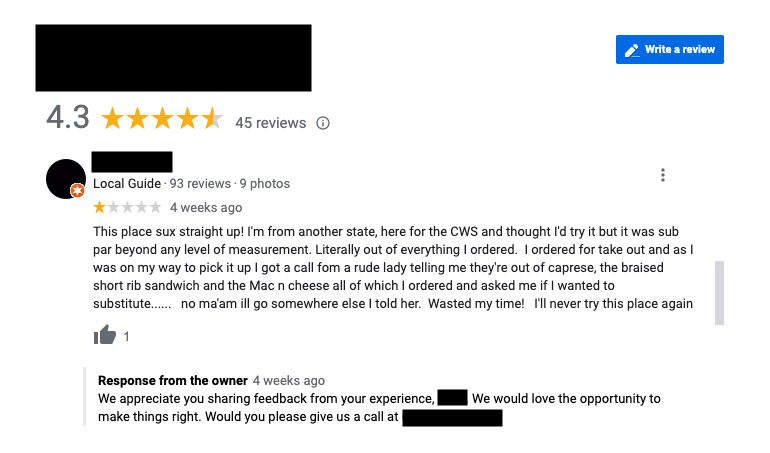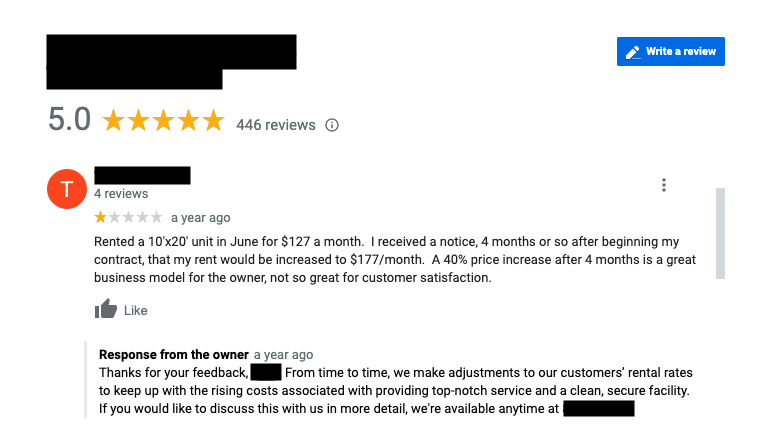As a business, you’re going to encounter some negative online reviews every now and then. Don’t worry! It isn’t the end of the world to get a negative review. In fact, responding to bad reviews can be an opportunity for you to showcase your customer service skills and maintain your online reputation.
How to Respond to Negative Reviews
While it may seem like you already lost the business of someone who leaves a one or two-star review, that doesn’t mean the reviewer should be ignored. In fact, 30% of negative reviewers turned positive after the businesses they reviewed responded to them. This is part of the reason why it’s important to respond to negative reviews effectively. Here are a few tips on how to respond to negative reviews:
1. Stay Calm
Don’t write an angry response in the moment that could damage your online reputation. Customers don’t want to see you react emotionally, blame others, or play the victim. They want to know that they matter to you and that you take their concerns seriously. So take a step back until you can respond with a level head.

Google also pays attention to the sentiment of the language on your review page. If the search engine notices you using inappropriate or aggressive language in a Google review, it could hurt your local search performance.
2. Talk Directly to the Reviewer
When responding to the reviewer, make sure they feel heard, not advertised to. Respond directly to their original review so that they can see your reply. At the beginning of your response, use the reviewer’s name (if they’ve provided it), and be sure to discuss the specific issue brought up in their review. It’s a bonus if you can use keywords related to your business when discussing their concerns.
Here are some examples of how to start a response directed at the reviewer:
- “Thank you for your feedback [name of reviewer]. Check your DMs for information on how to receive 50% off for your next visit”
- “We are sorry to hear about your experience [name of reviewer]. We appreciate the feedback and will be in contact to figure out how we can solve the issue.”
3. Take Responsibility
It doesn’t matter who’s at fault when a negative review pops up—businesses should always apologize. It’s unlikely you’re going to convince a disgruntled customer that they’re wrong, and it’s unprofessional to fight with customers online (not to mention that it could hurt your local search performance). Take responsibility for the problem the customer brought up without excuses. Show them that you care about listening to their concerns and solving the issue as best you can.

4. Offer a Solution
When working through an issue with a customer, try to provide helpful solutions for them. Maybe it’s offering free or discounted products, or letting the customer know that you’ve addressed the problem with your staff to avoid future incidences. Even saying something along the lines of “Send me a message so we can make this right” at the end of your response gives you and the customer an opportunity to find a resolution.
Here are some examples of review responses involving a solution:
- “Thank you for your feedback! We’ll be in touch with a refund and 50% off your next purchase”
- “We are sorry you had issues with our product. Be on the lookout for customer service to be in touch to figure out how we can get your product working or we’ll replace it for free!”
5. Thank the Customer
No matter the nature of a review, feedback is always a good thing. Thank reviewers for taking the time to let you know where you can improve—even if it’s an unfair business review that complains about things beyond your control. Do what you can to ensure the reviewer feels their concern is being addressed and that you look forward to providing a better experience the next time they visit your store or work with you.
Here are some examples of review responses thanking the reviewer:
- “Thank you for your review. I’m sorry to hear that your experience wasn’t up to par. Thank you for bringing this to our attention.”
- “Thanks for the feedback! We are always looking for ways to improve how we operate!”
6. Take It Offline
After your response to the original review, move the rest of the interaction with the customer offline, or at least off of the review page. This is good practice for several reasons—maybe the customer still isn’t satisfied with your response and wants to blast your business, or maybe you’re offering an exclusive deal to win them back. No matter what, stay positive and try your best to fix the situation. Also, keep in mind that just because you aren’t on the review page anymore doesn’t mean you can say whatever you want. The customer can post photos of the conversation to share your outstanding customer service…or otherwise.
Here are some lines to end your responses with to help your take these interactions offline:
- “Please check your DMs to let us know how we can get your a replacement.”
- “Please reach out to us at [contact info] so we can get some more information on your experience and get you a voucher for 50% off your next purchase.”
Why Do Negative Reviews Matter?
Negative reviews can sway potential customers’ buying decisions, but they can also block clients from finding you online. Google and other directories use reviews as a crowdsourcing method to determine the best options for online searchers.
In fact, online reviews are one of the most important local search ranking factors for Google. If you are repeatedly earning negative reviews, there is a good chance that will be reflected in your local search performance, especially if you have earned many negative reviews about the same issue—this shows you haven’t listened to customer feedback.
Earning a negative review here and there can be beneficial. A negative review mixed in with multiple positive reviews signals to Google that your business is legitimate. If you are consistently earning positive reviews, an occasional negative review won’t hurt you.
Having a few negative reviews can also help set the expectation of new customers. Obviously, you want your customer to expect the best from your business, but a reminder that things may not be perfect every single time can manage customer expectations.
For more information about managing negative reviews, check out our guide on how to delete a Google review.
Need help managing your local business listings? Local Search Fuel by Hurrdat is designed specifically to help small businesses claim, update, and manage their local listings. Get started today!



